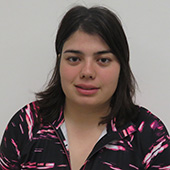Summer Research Internships for Undergraduates
 Temporal and Spatial Distribution of Wind Stress Fields and Arctic Sea-Ice Leads in the Chukchi Sea
Temporal and Spatial Distribution of Wind Stress Fields and Arctic Sea-Ice Leads in the Chukchi SeaPrior researchers have successfully applied the Mohr Coulomb Theory to large-scale brittle deformation features in winter sea-ice. This suggests that the stress-strain relationship of a sea-ice pack, presumably an isotropic, granular medium at macro-scales, can be determined given principal stresses and their directions. Sea-ice packs, however, are dynamic bodies, constantly subject to various, complex forces such as wind and ocean currents. By obtaining hourly AVHRR satellite imagery of the Chukchi Sea over a course of two months (December 2001-January 2002), we are able to observe the formation, propagation, and distortion of lead patterns, mainly ice arcs, in Arctic sea-ice at finer timescales. Additionally, these images are overlaid with wind stress fields and pressure contours to determine whether or not wind vectors can serve as proxies for the direction of maximum principal stress. Case studies reveal that brittle shear and tensile leads do appear to form at distinct recurring angles with respect to wind vectors. This implies that, at a first order of approximation, wind determines the dominant state of stress on sea-ice and frictional resistance from underlying ocean currents is negligible. At a qualitative level, the angles between leads and wind direction appear to be consistent with the values cited in prior literature. Quantifying these angles in future studies would affirm whether or not the Mohr Coulomb Theory, which assumes that a sea-ice pack is an isotropic entity, is applicable. Notably, however, sequential observations reveal cases in which the prior history of leads and wind stress can influence future temporal and spatial distribution of lead patterns.
 Interpreting a continuous CH4 record from the Taylor Glacier, Antarctica, deep ice core
Interpreting a continuous CH4 record from the Taylor Glacier, Antarctica, deep ice coreMeasurements of atmospheric gases preserved in air bubbles in ancient ice can provide information about the historical interactions between greenhouse gas cycles and climate. We have recorded continuous methane data from the BID DEEP3 core, an approximately 80-meter ice core from Taylor Glacier, Antarctica. Ablation at the site of coring has exposed roughly 50,000-year old ice at the surface, and gas record matching suggests that the gases in the ice sampled are ~92,000 years old at the bottom of the core. The continuous CH4 record matches previous Greenland and Antarctica core records with the exception of a low CH4 anomaly; from ~24 to 28 meters deep, CH4 drops to around 200ppb, which is about 150ppm lower than the lowest CH4 concentrations recorded in the last glaciation. This feature is replicated in the gas chromatographic analysis of discrete samples from the same core. Future investigation of other gases in this section of the core, such as CO2 and the isotopic composition of molecular oxygen, may reveal more information about the cause of CH4 depletion.
 Analysis of upper ocean temperature structure and surface waves in the Bay of Bengal using χSOLO floats
Analysis of upper ocean temperature structure and surface waves in the Bay of Bengal using χSOLO floatsAir-sea interactions in the Bay of Bengal are a major player in how monsoons behave. Upper ocean processes control the subsurface flux of heat and help regulate sea surface temperature thus influencing exchange with the atmosphere. A better understanding of how processes at the air-sea interface work could allow for more accurate predictions of short-term behavior of the active and break periods in monsoon rainfall. Here, we use recent measurements from a profiling float to characterize the surface wave field and temperature-salinity structure in the Bay of Bengal during the southwest monsoon. We focus on the development of the diurnal warm layer, and compare the measured temperature evolution to that predicted by the Price-Weller-Pinker model. We also use measurements of vertical velocity to quantify the period and amplitude of the dominant surface wave band; the expected connection between the local wind stress and wind wave height was observed as well as evidence of a remotely generated swell. Relationships between the character of the surface wave field and the near-surface structure of the diurnal warm layer will build a better understanding of how the atmosphere interacts with the upper layers of ocean.
 Robust and dynamically intuitive three-dimensional structures in extratropical flow variability
Robust and dynamically intuitive three-dimensional structures in extratropical flow variabilityTwo of the most fundamental processes in the atmospheric general circulation are: 1) net diabatic heating in the deep tropics and 2) the transport of angular momentum and heat by midlatitude eddies. The concept of separate subtropical (mostly thermally-driven) and midlatitude (mostly eddy-driven) jets are derived from these processes. We assess the three-dimensional structure of covariance in the tropospheric zonal wind field within the ERA-Interim Reanalysis data in order to study these driving processes, their importance in the large scale atmospheric circulation, and their interaction. Specifically, we examine the intrinsic teleconnectivity of the zonal wind field and compare it to the leading empirical orthogonal functions / principal components (EOFS / PCS) and with the patterns of thermal and eddy driving. The driving processes are clearly distinguishable within the three-dimensional variability of the zonal wind field, providing hope for a clearer and more physically meaningful characterization of climate variability and change. Interpreting a continuous CH4 record from the Taylor Glacier, Antarctica, deep ice core
 Plant and Soil Properties in Restored and Remnant Tidal Wetland Ecosystems in Salmon River, OR
Plant and Soil Properties in Restored and Remnant Tidal Wetland Ecosystems in Salmon River, ORThe Salmon River estuary has been developed, restored and studied for over 35 years. It provides unique habitat essential to the spawning cycles of vulnerable Pacific salmon fisheries. However, many studies have indicated that restoration efforts are falling short of reversing anthropogenic disruption and can likely benefit from additional research specific to Pacific Northwest tidal wetlands, particularly in the context of ecological management. For this study soil samples and vegetation surveys were taken in a remnant 'reference' marsh and three restored marshes along established transects within the estuary. The soil samples were then analyzed for oven- and air-dried bulk density, % plant fragments, pH, salinity, conductivity, and C/N ratios and surface areas. Using multidimensional ordination and modeling methods elevation and channel distances obtained from LiDAR satellite were linked to vegetation and soil data from each 1x1m plot to uncover significant gradients or patterns. These findings would provide new data on Pacific NW salt marshes and can potentially refine future salt marsh restoration approaches.
 Exploring effects of mesoscale eddy mixing in a global ocean circulation model
Exploring effects of mesoscale eddy mixing in a global ocean circulation modelMixing along isopycnal (equal density) surfaces due to mesoscale eddies is a key mechanism for the transport of heat, salt, and other biogeochemical tracers, including the absorption of anthropogenic greenhouse gases throughout the ocean. Much of the wind energy input into the ocean is removed by mesoscale eddies through baroclinic instability. Studies have suggested that mesoscale eddies interact with bathymetry and cause deep ocean diapycnal mixing. Therefore mixing due to mesoscale eddies may impact the large scale circulation and tracer distributions. However, global coarseresolution ocean models lack the resolution necessary to directly simulate mesoscale eddies. Here we implement parameterizations of mesoscale eddy mixing that use spatially variable isopycnal thickness diffusivities into an existing ocean component of a global climate model and study their effects on the large scale circulation and tracer distributions. We show that using spatially variable diffusivities alters the time mean equilibrium ocean circulation in the model when compared to the spatially constant isopycnal and thickness diffusivities.
 Evaluation of Random and Length Stratified Otolith Sampling to Establish Size-at-Age of Pacific Cod in the Bering Sea
Evaluation of Random and Length Stratified Otolith Sampling to Establish Size-at-Age of Pacific Cod in the Bering SeaStock assessment of Pacific cod in the Bering Sea relies heavily on accurate estimates of size-at-age relationships of the species. Presently, there is speculation that traditional assessments of Pacific cod size-at-age are inconsistent with a true representation of the population, due to an inadequate age data sampling strategy. It is debated whether the sampling strategy in practice appropriately accounts for environmental variables, which are known to affect fish growth and influence the size-at-age function. By evaluating discrepancies between the traditional length stratified sampling and a novel random stratified sampling, we aimed improve stock assessment of one of the most ecologically and economically significant Alaskan groundfish species. Data obtained by these two methods in 2015 were used to characterize difference in determining size-at-age models, interpreting effects of environmental variability in size-at-age, and predicting the age distribution of the population. Additionally, a complete sampling strategy evaluation in which both sampling strategies were simulated on a virtual population of Pacific cod was used to test the efficacy and accuracy of each protocol. Results indicate that the length stratified sample is biased in that it does not adequately account for spatial variability in Pacific cod size-at-age. Alternatively, it was found that the random stratified sampling strategy is able to represent spatial heterogeneity, making the design a more precise predictor of age data observed in the population. However, the sampling strategy evaluation suggests that although random stratified sampling is more precise, both sampling strategies lack in accuracy, thus implying that there is some bias in biomass estimates from both sampling strategies. Additional analyses on the effects of environmental conditions (e.g., warm vs cold years), sampling, and age measurement errors are currently underway to characterize the conditions under which one sampling strategy may prevail over the other.
 Post 6.3 Ma erosionally driven rock uplift and landscape evolution of the Cascade Range in the Pacific Northwest
Post 6.3 Ma erosionally driven rock uplift and landscape evolution of the Cascade Range in the Pacific NorthwestThe appearance of plutons at the earth's surface, the upward displacement of paleo-valley markers, and high relief demonstrate active rock uplift and exhumation of the Cascade Range of the Pacific Northwest. Despite observations that long-term exhumation of the Cascade Range covaries with orographic precipitation, the relative importance of tectonic deformation and erosion in rock uplift in Oregon's Western Cascade Range is largely unknown. To determine the magnitude of erosion-related rock uplift, we compiled existing geological, geophysical, and chemical analyses. Basalt flows now exposed along ridges are thought to have followed paleo-valleys and provide markers that constrain the volume of material eroded since ~6.3 Ma. Analysis using ArcGIS and MAT lab provided an estimate of the eroded volume following the emplacement of lava flows and enabled modeling of the isostatic response to mass removal. An eroded volume of 314.6 to 695.5 km^3 (average thickness of 205.4 to 454.2 m/km^2) for the middle Santiam drainage is represented by the difference between the modern topography and a surface reconstructed from the 6.3 Ma flows. Area averaged erosion for the drainage is 32.6 m/Ma (0.03 mm/yr) to 72.1 m/Ma (0.07 mm/yr). In the case of perfect isostatic compensation, mass removal from the drainage yields 173.1 to 384.3 m (278.7±105.6 m) of rock uplift over the past 6.3 Ma. This rock uplift explains approximately 61.9±23.4% of the elevation difference between the paleo-valley markers and valley bottoms. The calculation likely overestimates the isostatic response given that an Airy isostatic model does not account for plate rigidity. Flexural modeling better illustrates the effects of variably distributed load on rock uplift across the western flank of the Cascades. The degree of isostatic compensation within flexural models varies with plate continuity. With an elastic thickness of 10 km, a continuous plate model results in a relatively smaller amount of rock uplift (217.5±67.5m) in the core of the range whereas a broken plate model allows for greater rock uplift (262.5±87.5 m). Preliminary findings suggest that erosional mass removal explains at least half of the upward movement of rock in the Western Cascades. Thus our results indicate that tectonic deformation, magmatic addition to the shallow crust, and/or other processes exert a control equal to erosion on the evolving landscape of the Cascade Range.
 Evaluating Temporal Trends and Sources of Lead in the Columbia River Gorge Using Epiphytic Lichens and Lead Isotopes
Evaluating Temporal Trends and Sources of Lead in the Columbia River Gorge Using Epiphytic Lichens and Lead IsotopesThe Columbia River Gorge (CRG) is a region between Washington and Oregon with complex topography and sparse instrumented air monitoring sites. Lead (Pb) pollution in the CRG originates from both natural and anthropogenic sources. Anthropogenic Pb sources include vehicular exhaust, diesel exhaust from trains and marine vessels, power plant emissions, and pollution from the city of Portland. After this Pb is released into the atmosphere, it can be transported and accumulate in the environment. Ephiphytic lichens accumulate metals in their tissue, absorbing them directly from the atmosphere. Their tissue concentrations reflect environmental metal levels and can be used to assess air quality over a large geographical range. This study uses lichens to evaluate decadal changes in atmospheric Pb deposition in the CRG and to identify Pb sources and relative contribution using Pb isotope ratios. The USDA Forest Service Air Program collected lichen samples from the CRG between 1993 and 2014. Lichen Pb concentrations reveal a steep decline in the atmospheric deposition of Pb over the past 20 years. The maximum observed Pb concentration decreased by a factor of ~10 between 1993-1994 and 2013-2014 for each of the three target species collected in the highest abundance: from 94 to 9.2 ppm for Platismatia glauca (87 samples), 50 to 3.8 ppm for Evernia prunastri (112 samples), and 45 to 5.6 ppm for Hypogymnia inactiva (47 samples). Pb isotopes evaluated the relative importance of pollution from the city of Portland to the west, natural background levels in the CRG, and historical leaded gasoline emissions.
 Quantifying sediment and carbon accumulation rates since 1850 in a Nehalem Bay salt marsh, Oregon
Quantifying sediment and carbon accumulation rates since 1850 in a Nehalem Bay salt marsh, OregonTo better understand the role of tidal elevation in controlling carbon and sediment accumulation rates, three sediment cores were taken in Nehalem estuary on a transect from low intertidal mud flats through high marsh. The cores provided sediment samples for nondestructive and destructive analysis using CT and XRF scans, LOI, and γ-spectroscopy analysis. Average dry bulk density for the top 50 cm of the mud flat, low marsh, and high marsh core were 1.78, 1.50, and 0.62 g/cm3, respectively. Organic matter content in each core decreased with depth but increased overall with elevation gain; average OM was 4.5%, 8.1%, and 26.5% from the mudflat to low marsh to high marsh, respectively. Sediment accretion rates, obtained from excess 210Pb activities using the constant initial concentration method (CIC) were 0.320 cm/yr in the low marsh and 0.391 cm/yr in the high marsh. Interval sediment accretion rates, determined by the constant rate of supply method have been increasing steadily in the marshes over the last 70-150 years, with recent spikes in sediment accretion rates, by 0.24 and 0.34 cm/yr in Cores 7 and 8, respectively, over the last 10-20 years. Carbon mass accumulation rates in the low and high marsh were 109.3 and 225.1 gC/cm2/yr, respectively. Differences in tidal height and vegetation between coring sites are possible factors being considered in understanding the spatial variation in accumulation rates, whereas a 500-yr return flood in 1996 may have led to observed acceleration. Ongoing analysis in other areas of the marsh are needed to determine if this pattern is robust.
 Particle Size Analysis for Holocene Paleoenvironmental Study of Steens Mountain, Eastern Oregon
Particle Size Analysis for Holocene Paleoenvironmental Study of Steens Mountain, Eastern OregonIn order to better understand climate trends in the late Pleistocene and early Holocene in southeast Oregon, we present an analysis of grain size data from Fish Lake in Harney County Oregon. Fish Lake (42° 44' 15" N, 118° 38' 57" W, 2,246.7 m) sits on the west slope of Steens Mountain, a fault-block mountain of Miocene basalt, adjacent to glacial moraines. The present environment is high desert, with sub alpine steppe vegetation and receiving approximately 12" of precipitation annually. Sediment core samples used in this study were taken in August of 2013 and have been analyzed using X-Ray Fluorescence (XRF) and Loss On Ignition (LOI) methods; an age-depth model using terrestrial macrofossils has also been developed. Using this model, the sediment cores have been determined to encompass the last 13 k years of deposition. The recovered sediments consist of fine terrigenous and biotic material in varying proportions. Six distinct tephras have been identified, providing points of reference with which to correlate relative depths of different cores. XRF and LOI data show an interval lasting from 12-8 ka during which the sediment was low-density, sedimentation rate was low, and the biotic component relative to the terrigenous component of the sediment was high. These data together suggest that the water level of the lake was low during this interval, indicating a more arid environment. This interval roughly correlates with a hiatus in stalactite growth observed in Oregon Caves National Monument on Oregon's Pacific coast, another indicator of dry conditions. To expand on these existing data, sediment grain size was measured for the last 13 k years using a Beckman Coulter Particle Size Analyzer. Terrigenous sediments in Fish Lake from 12-8 ka have a larger average size than sediments from the rest of the cores, providing further evidence for low lake levels during that time.
 Spatial-temporal variability in the diet of Antarctic krill: A stable isotope approach
Spatial-temporal variability in the diet of Antarctic krill: A stable isotope approachRising temperatures along the Western Antarctic Peninsula (WAP) have led to a shorter winter season and a decrease in winter sea-ice, which are negatively correlated to primary productivity in the region. Greatest changes have been observed along the northern WAP. Phytoplankton community structure has shifted from diatoms towards smaller phytoplankton over the past two decades, which has likely impacted the diet of Euphausia superba in the WAP region. The spring and early summer diet of E. superba is primarily diatoms. However, during other times of the year when diatoms are not available, E. superba feeds on copepods and microzooplankton. We hypothesize that the shift in spring-early summer phytoplankton community structure along the WAP will have resulted in a shift in the trophic position of E. superba between the northern and southern WAP and between 1993 and 2008. We will test our hypothesis by analyzing δ15N of E. superba collected along the WAP in 1993 and 2008. Since δ15N increases approximately 3‰ at each trophic level (Popp et al., 2007), we expect that E. superba will have higher δ15N levels in the northern WAP during both years and in 2008, overall.
 80 Million Years of Prolonged and Localized Fluid flow and Alteration on Shatsky Rise
80 Million Years of Prolonged and Localized Fluid flow and Alteration on Shatsky RiseShatsky Rise is a large igneous province (LIP) in the northwest Pacific Ocean, which formed at an unstable ridge-ridge-ridge (RRR) triple junction at the Jurassic/Cretaceous boundary, 147 mya. 40Ar/39Ar analyses of samples from TAMU and Ori Massif, two large scale volcanic features on Shatsky Rise, yield mixing ages between fresh plagioclase and sericite phases that range from several million years younger than the eruption age of 147 mya, to one analysis that was approximately 80 myr younger than the eruption age. This alteration, indicated by the presence of celadonite (in void spaces) and sericite replacing plagioclase is caused by two things. Prolonged fluid flow, which can be found on IODP (Integrated Ocean Drilling Program) holes (1) U1347A, (2) U1349A, (3) U1350A, and (4) U1346A. Such fluid flow is also found on lesser extend on ODP (Ocean Drilling Program) hole 1213B. Localized fluid flow is evident in IODP hole U1350A, where particularly young ages approximately 80 myr younger than the age of eruption are found in a unit of altered pillow basalt with interpillow sediment. Celadonite and sericite 40Ar/39Ar alteration ages were determined by collecting the individual aggregates of celadonite and grains of sericitic plagioclase by means of sieving, washing, magnetic separation, and mild acid leaching. Since the ages obtained are a mixture between fresh plagioclase and sericitic plagioclase, the true age of alteration cannot be obtained, the Verati and Jourdan model was employed with moderate success, which showed a substantial drag on 40Ar/39Ar steps toward the beginning of the step heating increments, but leveled out towards a plateau age at the end of the run. The ages were obtained using 40Ar/39Ar geochronological incremental heating analyses that used the ARGUS VI 40Ar/39Ar multi-collector mass spectrometer. Overall, Shatsky Rise shows that prolonged fluid flow is possible in large igneous provinces (LIPs), although the overall mechanism is still poorly understood.